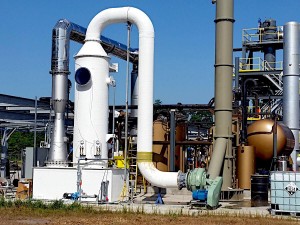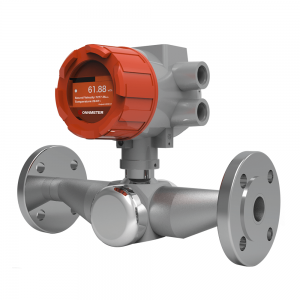In the chlor-alkali industry, sulfuric acid concentration measurement is critical for efficient chlorine drying in drying towers and scrubbers. The chloric gas is ought to be removed from its water components to avoid formation of chlorine hydrate, lowering the moist content of chlorine gas below 30 ppm of to reduce equipment corrosion in following processing.
Dehydration in absorption tower or scrubber requires continuous sulfuric acid concentration monitoring to guarantee efficiency of chlorine drying and consistent products of other byproducts.
Nevertheless, challenges like fouling, scaling, calibration complexity, and inconsistent measurements can disrupt chlorine drying towers and dry scrubbers for chlorine gas, leading to increased costs and compliance risks. Process engineers, operations managers, and quality control professionals in chlor-alkali plants seek reliable H₂SO₄ concentration meters and sulfuric acid concentration meters to address these issues. This article explores how to control inline sulfuric acid concentration, offering solutions to optimize chlorine drying columns and improve efficiency. Read on to discover actionable strategies and advanced tools for your operations.

Chlorine Drying Process Overview
In the chlor-alkali process, wet chlorine gas (Cl₂) produced from brine electrolysis contains moisture that must be removed to ensure purity and prevent corrosion in storage or downstream applications. Chlorine drying towers or dry scrubbers for chlorine gas use concentrated sulfuric acid (93–98%) as a desiccant to absorb moisture, producing dry, high-purity chlorine gas. Accurate sulfuric acid concentration measurement is essential to maintain drying efficiency, as deviations can lead to incomplete drying or equipment damage.
Technical Challenges in Sulfuric Acid Concentration Measurement
Corrosion and Sensor Fouling
The high acidity of sulfuric acid (93–98%) in chlorine drying towers causes corrosion and fouling on H₂SO₄ concentration meters. Deposits from acid or impurities reduce sensor accuracy, requiring frequent cleaning or replacement. This increases maintenance costs and downtime, impacting the efficiency of dry scrubbers for chlorine gas.
Calibration Challenges
Sulfuric acid concentration meters require frequent calibration due to the harsh environment of chlorine drying columns. Variations in temperature, pressure, or acid composition can cause sensor drift, complicating calibration and leading to unreliable measurements. Manual calibration is labor-intensive and increases operational complexity.
Inconsistent Drying Efficiency
Fluctuations in H₂SO₄ concentration can result in incomplete moisture removal, affecting chlorine purity and downstream processes like PVC production. Over-diluted acid (due to moisture absorption) reduces drying efficiency, while overly concentrated acid can damage equipment, making precise sulfuric acid concentration measurement critical.
Regulatory and Safety Risks
Inaccurate sulfuric acid concentration measurement can lead to moisture in chlorine gas, causing corrosion in storage systems or non-compliance with safety and environmental regulations. Regulatory scrutiny in the chlor-alkali industry (e.g., EPA, OSHA standards) demands precise control to avoid penalties or safety hazards.
Solutions for Inline Sulfuric Acid Concentration Control
Corrosion-Resistant H₂SO₄ Concentration Meters
To combat corrosion in chlorine drying towers, advanced H₂SO₄ concentration meters produced by Lonnmeter use corrosion-resistant materials like Hastelloy, Teflon, or ceramic coatings. These sensors withstand the aggressive 93–98% sulfuric acid environment, ensuring long-term reliability and reducing maintenance costs.
Explore more inline concentration meters here.
Advantages of Lonnmeter Sulfuric Acid Concentration Meter
Safe and Non-Nuclear Technology
Environmentally Friendly: Utilizes safe, non-radioactive ultrasonic technology, free from environmental restrictions and ensuring compliance with safety standards in chlorine drying processes.
Simplified Maintenance: Eliminates the need for nuclear source replacement, reducing maintenance complexity and costs in chlorine drying towers.
Exceptional Accuracy
Bubble and Foam Immunity: Delivers precise sulfuric acid concentration measurement, unaffected by bubbles or foam, ensuring reliable data in dry scrubbers for chlorine gas.
Robust Performance: Resistant to operational pressure, fluid abrasion, and corrosion, maintaining high accuracy in harsh chlorine drying column environments.
Cost-Effective Operation
Low Operating Expenses: Minimizes operational costs, making it an economical choice for continuous H₂SO₄ concentration monitoring in chlor-alkali plants.
Superior Lifecycle Value: Offers a lower total cost of ownership compared to inline tuning fork density meters and mass flow meters, ideal for long-term use in chlorine drying.
User-Friendly Design
Intuitive Operation: Simplifies sulfuric acid concentration measurement with an easy-to-use interface, reducing training time for operators in chlorine drying towers.
Versatile Output Options: Provides dual readings involving temperature, velocity and concentration at the same time, enhancing flexibility for process control in dry scrubbers for chlorine gas.
Flexible Installation Options
Multiple Installation Methods: Supports insertion, flange, and clamp-on types, offering adaptability to various chlorine drying system configurations.
Customizable Integration: Seamlessly integrates into existing setups, optimizing installation efficiency for H₂SO₄ concentration meters in chlor-alkali operations.
Integration with Real-Time Inline Monitoring Systems
Lonnmeter Inline sulfuric acid concentration meters enables integration with distributed control systems (DCS) or programmable logic controllers (PLC) to adjust acid dosing automatically, optimizing drying efficiency and reducing energy consumption.
Minimizing Maintenance Downtime
To reduce downtime, H₂SO₄ concentration meters with long service intervals and predictive maintenance features are essential. These systems use diagnostics to alert technicians to potential fouling or drift, allowing proactive maintenance in chlorine drying towers.
Ensuring Regulatory Compliance
Sulfuric acid concentration meters with robust data logging and integration with plant control systems ensure compliance with environmental and safety regulations. Real-time monitoring and automated reporting help chlor-alkali plants avoid penalties and maintain high safety standards.
FAQs
How to Control the Inline Concentration of Sulfuric Acid?
Controlling inline sulfuric acid concentration in chlorine drying towers requires H₂SO₄ concentration meters with corrosion-resistant materials and real-time monitoring capabilities. Integrate these meters with DCS/PLC systems for automated acid dosing.
What Are the Best Sulfuric Acid Concentration Meters for Chlorine Drying?
The best sulfuric acid concentration meters for chlorine drying columns are corrosion-resistant and capable of real-time monitoring. Choose meters with DCS/PLC integration and predictive maintenance features to minimize downtime.
How Do I Address Sensor Fouling in Chlorine Drying?
Sensor fouling in dry scrubbers for chlorine gas can be addressed with H₂SO₄ concentration meters featuring anti-fouling coatings and keeping concentration below the point of fouling and scaling. Regular maintenance schedules and in-line pretreatment to remove impurities also help reduce fouling, ensuring reliable sulfuric acid concentration measurement.
Controlling inline sulfuric acid concentration in chlorine drying towers and dry scrubbers for chlorine gas is essential for efficient chlor-alkali operations. By addressing tricky technical challenges like sensor fouling, calibration challenges, and inconsistent drying with advanced H₂SO₄ concentration meters and real-time monitoring systems, chlor-alkali plants can optimize efficiency, reduce costs, and ensure compliance.
Contact the leading and trusted supplier Lonnmeter of sulfuric acid concentration meters today to request a quote or demo and transform your operations. Or you can contact with our engineers for customization services like customized installation method, material, and integration system.
Post time: Jun-19-2025











